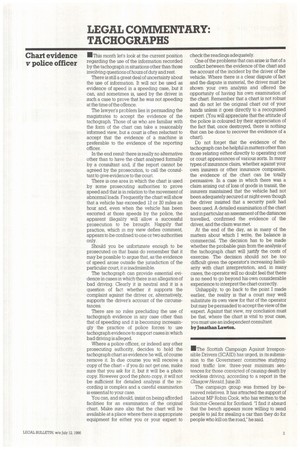Chart evidence v police officer
Page 29

If you've noticed an error in this article please click here to report it so we can fix it.
• This month let's look at the current position regarding the use of the information recorded by the tachograph in situations other than those involving questions of hours of duty and rest, There is still a great deal of uncertainty about the use of information. It will not be used as evidence of speed in a speeding case, but it can, and sometimes is, used by the driver in such a case to prove that he was not speeding at the time of the offence.
The lawyer's problem lies in persuading the magistrates to accept the evidence of the tachograph. Those of us who are familiar with the form of the chart can take a reasonably informed view, but a court is often reluctant to accept that the evidence of a machine is preferable to the evidence of the reporting officer.
In the end result there is really no alternative other than to have the chart analysed formally by a consultant and, if the report cannot be agreed by the prosecution, to call the consultant to give evidence to the court.
There is one area in which the chart is used by some prosecuting authorities to prove speed and that is in relation to the movement of abnormal loads. Frequently the chart will show that a vehicle has exceeded 12 or 20 miles an hour and, even when the vehicle has been escorted at those speeds by the police, the apparent illegality will allow a successful prosecution to be brought. Happily that practice, which in my view defies comment, appears to be confined to one or two authorities only.
Should you be unfortunate enough to be prosecuted on that basis do remember that it may be possible to argue that, as the evidence of speed arose outside the jurisdiction of the particular court, it is inadmissible.
The tachograph can provide essential evidence in cases in which there is an allegation of bad driving. Clearly it is neutral and it is a question of fact whether it supports the complaint against the driver or, alternatively, supports the driver's account of the circumstances.
There are no rules precluding the use of tachograph evidence in any case other than that of speeding and it is becoming increasingly the practice of police forces to use tachograph evidence to support cases in which bad driving is alleged.
Where a police officer, or indeed any other prosecuting authority, decides to hold the tachograph chart as evidence he will, of course remove it. In due course you will receive a copy of the chart if you do not get one, make sure that you ask for it, but it will be a photo copy. However good the photo copy, it will not be sufficient for detailed analysis if the recording is complex and a careful examination is essential to your case.
You can, and should, insist on being afforded facilities for an examination of the original chart. Make sure also that the chart will be available at a place where there is appropriate equipment for either you or your expert to check the readings adequately.
One of the problems that can arise is that of a conflict between the evidence of the chart and the account of the incident by the driver of the vehicle. Where there is a clear dispute of fact and the dispute is material, the driver must be shown your own analysis and offered the opportunity of having his own examination of the chart. Remember that a chart is not robust and do not let the original chart out of your hands unless it goes directly to a recognised expert. (You will appreciate that the attitude of the police is coloured by their appreciation of the fact that, once destroyed, there is nothing that can be done to recover the evidence of a chart).
Do not forget that the evidence of the tachograph can be helpful in matters other than those relating either directly to operating cost or court appearances of various sorts. In many types of insurance claim, whether against your own insurers or other insurance companies, the evidence of the chart can be totally persuasive. In a case in which there was a claim arising out of loss of goods in transit, the insurers maintained that the vehicle had not been adequately secured at night even though the driver insisted that a security park had been used. A detailed examination of the chart and in particular an assessment of the distances travelled, confirmed the evidence of the driver, and the claim was met.
At the end of the day, as in many of the matters about which I write, the balance is commercial. The decision has to be made whether the probable gain from the analysis of the tachograph chart will justify the costs of exercise. The decision should not be too difficult given the operator's increasing familiarity with chart interpretation, and, in many cases, the operator will no doubt feel that there is no need to go beyond his own considerable experience to interpret the chart correctly.
Unhappily, to go back to the point I made earlier, the reality is that a court may well substitute its own view for that of the operator but may be persuaded to accept the view of the expert. Against that view, my conclusion must be that, where the chart is vital to your rase, you must use an independent consultant.
by Jonathan Lawton.




















































































